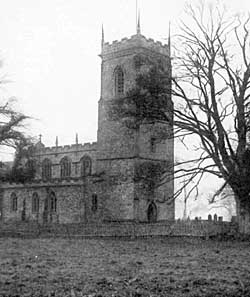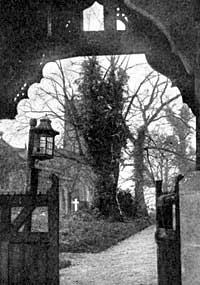
When William Stretton (architect and historian) visited the place in 1818, he described it as "a neat stone church of cleansed ashlar." The term "cleansed" which he chose for the outer stonework might well be applied to the interior to-day, for Stanford Church impresses with its scrupulous freshness.
Granted that it has undergone much restoration in the last fifty years and that the "church architect" label is somewhat in evidence, one feels the effect of a bright and cheerful atmosphere. Evidence of wealth is here, but it is well applied through craftsmen of ability who have brought reverential treatment to their labours, uniting old and new to the glory of God and the memory of those whose lives are here commemorated.
Dedicated to St. John the Baptist, it is natural that the font should have received rather special consideration and, with its richly carved alabaster, is a marked feature of the edifice, contemporary with the screen and carved oak reredos. The latter presents the three most significant acts of the Christian cycle, the Birth, Baptism and Resurrection of our Lord.
In the south wall of the Chancel is one of those so-called "low side windows," the upper part of which was evidently closed by a shutter. Through this opening, in pre-Reformation times, the sound of the sacring bell was carried to the outer world, calling for a moment the attention of those who laboured in the fields to something beyond the mere drudgery of their daily task.
The vault of the Lewis' and Dashwoods' obtrudes at this end of the south aisle—a somewhat austere and unsatisfying feature with its plain tiled cover. But what is lacking in the vault itself is made good by the memorials in the form of glass, wall tablets and brasses which commemorate generations of these families who in succession owned and helped in maintaining the edifice in which they lie.
Thus we are reminded of "Samuel Vere Dashwood, for 49 years Rector of this Parish, who died 10th November, 1876, aged 72 years, by his seventeen children and his surviving sister." He was a squarson who joined heartily in the sport as well as in the religious life of his district, being a popular figure in the hunting field. Two other Dashwoods, Samuel Francis, M.A. (1801-1826) and Robert Lewis, B.A. (1877-1881) figure in the list of Rectors which goes back to the year 1229, when Robert de Gloucester held the living under the patronage of the famous Walter Grey, Archbishop of York.

Lists of Rectors such as this are of wider interest than that of merely giving particulars of the successive incumbents. They tell us who held the gift of the living from time to time—thus we find Hugh de Stanford succeeding the Archbishop of York and William Bigge (who himself held the living for six years) appearing as patron with Hugh when John de Normanton was instituted in 1280. The Bigge family continued their holding for over eighty years, for Johanna of that ilk is entered for 1361, the year Nicholas de Sutton was appointed to the living. There is a good local flavour about such names as that of John de Normanton, Robert of Loughborough acolite (1305), Adam de Rothley (1354) and John de Barrow-on-Soar (1368).
King Henry VII appears as guardian of the Manor of Richard Illingworth, a name which we find recorded on an incised alabaster slab of "Rad'us Illyngworth, gentleman and Agnes his wife, 1498," which (in the manner of the time) begs prayers for their souls.
Another king, James the First, became patron "by lapse," in 1615.
There is a fine brass of a Priest, commemorating that Adam de Rothley already mentioned, who held the living in the latter half of Edward the Third's reign. The inscription has disappeared, a fate which has also overtaken another of these interesting memorials. Only the matrix remains to indicate where the praying figures were set in the slab.
Doctor Thoroton, the historian, states that in his day the arms of Swillington appeared in one of the Chancel windows (Robert Swillington having been patron 1380), but this, and other early memorial glass of which he speaks, alas, disappeared long ago.
But the student of heraldry will find plenty to engage his attention in the many armorial records of alliances of the Lords of the Manor, and those who are not deeply versed in the subject may easily pick out the lion and boar's heads of the Lewis' and the griffin's heads which grace the Dashwood family shield.
The union of the two families is to be met with in a wall tablet which tells us that "Francis Lewis of Stanford Esq., by a peculiar vivacity, and agreeable turn of thought, with a sound Judgement, strict Honour, inflexible Justice, and a benificent Disposition improv'd and perfected by a clean knowledge and serious Practice of Religion, highly adorned all the offices of Life," while his wife, Sophia, daughter of Sir Samuel Dashwood, was "A lady whose Life was truly useful and endearing by an Amiable Display of the Social, and a sincere practice of all the Christian Virtues." Appreciation could not be expressed in much higher terms.
Most visitors are interested in the recumbent effigy which lies in an arched recess within the north wall. It represents a civilian with dirk, pouch and sword of fourteenth century fashion, and may represent the benefactor who built this aisle of the church.
The registers are not, of course, generally accessible to the casual visitor, but they help to give life to the history of the parish. Thus, we learn that Nicholas Chamberlaine who commenced the writing of the registers with all due care and formality in the year 1633, ventured a second time upon the Seas of Matrimony with Dorothy Musson and entered the publication of their banns in 1656.
The tradition that Stanford once figured as a local Gretna Green is in a measure substantiated by these long, narrow pages, for during the incumbency of the Rev. Francis Thwaytes, M.A. (1686-1720), couples from distant parts of Nottinghamshire and Leicestershire came here for the marriage ceremony—even Gloucestershire figures in the list. While Stanford was undoubtedly a charming setting for a wedding, there must have been some further reason for its popularity. Perhaps it does not matter now whether the Reverend Mr. Thwaytes was particularly attractive or decidedly lax, or whether some belief was current in the good luck attendant upon a celebration within the walls of Stanford Church, but we can afford to take a charitable view.
With this first register are bound several old terriers (or property lists) describing the Rectory. This is not the house occupied as such to-day, but the farmhouse which has recently been renamed with the rather attractive title "Five Oaks." The present Rectory with its Georgian front and long, square-paned south windows was formerly a Dower House.
Legend speaks of a fierce encounter having taken place in the Rectory field between rival companies of bowmen; credence was given to this story by the finding of many skulls of young men hastily interred when the Dashwood vault was enlarged.
The old yew in the churchyard is also said to have shadowed Charles I and his faithful henchman, Sir Henry Skipworth in conference prior to the siege of Leicester which terminated in one of those vicious actions so liable to mark the bitter conduct of internecine warfare.
The placid winding Soar does not suggest tragedy, but when its waters spread beyond their normal limits it can be full of menace. Thus in time of heavy flood a Miss Palmer, of Wanlip, travelling to visit friends in Nottinghamshire, came in her coach to Stanford Ford. Coach, horses, man and passenger were all swept away and drowned in the tearing current.
But we will think of Stanford as it appears on a fine summer's day when many folk from the surrounding districts are called to service and a pleasant walk by its bells; or when one of the popular cricket fixtures arranged by the squire has drawn us to the Hall fields and we have been privileged to wander in the charming gardens which now take the place of "that barren hill" whereon the manor house once stood.
